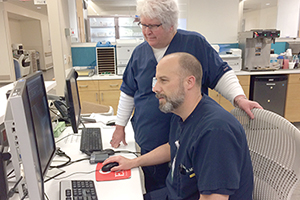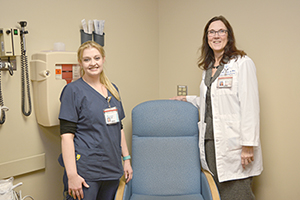By BETSY TAYLOR
Is there a way to move patients through emergency departments to reduce their wait times and the total length of their visits? A study comparing two models of patient flow offers some evidence that a hybrid approach outperforms traditional triage.

"Patients come to us expecting to be treated quickly, and we need to improve our systems to make that happen," said Beth Pierce, director of emergency services at Mercy Health – West Hospital in Cincinnati. She and Denise Gormley, an associate professor and coordinator of the University of Cincinnati's nursing administration program, completed a quality improvement project in 2015 that evaluated models related to patient flow in emergency departments at two Mercy Health community hospitals in Cincinnati.
Both emergency departments had similar patient volumes, with about 34,000 patients discharged in 2014 from each department. Both departments offer the same variety of services, the researchers said.
The researchers found two models developed in recent years, a "split flow" model of care delivery and the "provider-in-triage" model, when used in tandem, reduced length of stay in emergency departments compared with the traditional nurse triage model of care management.
Their findings were published in the November 2016 issue of the Journal of Emergency Nursing in an article called: "Are Split Flow and Provider in Triage Models in the Emergency Department Effective in Reducing Discharge Length of Stay?"
Traditional model
Pierce and Gormley compared patient flow and total visit times in the emergency department at Mercy Health – Anderson Hospital in Cincinnati to the patient flow and service times at Mercy Health – West Hospital. Mercy Health – Anderson uses the traditional triage model. Mercy Health – West Hospital, which opened in 2013, uses a combination split flow and provider-in-triage model. (The study excluded data from patients who arrived by ambulance.)
When an ambulatory patient comes to the emergency room at Mercy Health – Anderson, and that person does not require immediate critical care, the registrar at the reception desk completes a "quick registration" by entering the patient's name and chief complaint into the electronic medical record, which adds that patient's name to an electronic board used to track the emergency department's caseload. The patient stays in a waiting area until a triage nurse conducts a brief assessment in a triage room and assigns an acuity level, to indicate how long a patient can safely continue to wait for a medical examination and treatment.
Triage nurses in the U.S. commonly use the Emergency Severity Index, a scale that ranges from 1 for high acuity to 5 for low acuity. Pierce and Gormley said high acuity patients are moved directly from a triage room to a treatment room designated for critical care patients. Pierce said after the traditional triage is completed, during times of high volume, patients often are directed back to the waiting room until a treatment bed becomes available. Once the patients are in a treatment room, the provider — either a physician, nurse practitioner or physician assistant — decides who will be seen first. Some protocols, such as a blood draw for laboratory tests or an electrocardiogram, can be performed in the triage room.
Split flow and provider in triage
In the hybrid split flow, provider-in-triage model, the registrar takes very basic information when the patient first arrives and directs the patient to a pivot room, with eight curtained partitions and recliners.
That's where the emergency department supervisor — the pivot nurse — performs a "quick triage" documenting the patient's chief complaint, vital signs, allergies, pain score and Emergency Severity Index score in the patient's electronic medical record. In this model, lower acuity patients with Emergency Severity Index levels of 3, 4 or 5 are placed in a separate queue from patients with an index level of 2 or 1. The tracking board updates based on the electronic data to indicate the patient is ready for the provider in triage — a physician, nurse practitioner or physician assistant — to determine if the patient should be routed to a rapid evaluation unit if they have less acute presentations, or the acute care unit for patients with higher acuity presentations.
Thus, the split flow model splits the volume of emergency department patients into two groups, one of higher acuity patients and one of lower acuity patients. Nurses and other providers rotate between the higher acuity and lower acuity treatment areas.
Any patient with a potentially life-threatening illness or injury would immediately be brought to the acute care unit within the emergency department by an emergency department nurse, Pierce said.
The provider in triage and the pivot nurse collaborate in the pivot room, so that protocol orders can be initiated there, or a patient who is not in need of additional care can be immediately discharged.
The split flow model on its own reduced time to discharge for all emergency patients and when used in tandem with the provider-in-triage model, even greater reductions were realized, Pierce said.
In the traditional triage model, the average door-to-bed time was five minutes, the door-to-provider time was 12.9 minutes and the length of stay before discharge was 173.8 minutes.
Under the split flow model alone (without the use of the provider-in-triage model), the door-to-bed time was eight minutes, the door-to-provider time was 20 minutes and the average length of stay before discharge was 157.5 minutes.
Where both the split flow model and the provider-in-triage model were used, the patient moved more rapidly through the emergency department, with a 1.6 minute average time from door to bed, 10.6 minutes from door to provider and an average length of stay of 145.3 minutes before discharge.
Pierce said many hospitals these days are doing some version of split flow; she thinks the notable findings were that it shortened length of stay when used together with the provider-in-triage model.
Emergency departments keep patients moving  Nurse Kari Cochran, left, and Theresa Gregg, director of emergency and trauma services for CHI Health Creighton University Medical Center in Omaha, Neb., show a recliner that replaces an exam table in a low acuity area of the E.R. The chair can be quickly disinfected to speed room turnover. Catholic Health Initiatives' Kentucky-One Health in Louisville, Ky., and CHI Health in Omaha, Neb., have taken steps to shorten the time patients spend in their emergency rooms by separating out higher and lower acuity patients. Both KentuckyOne Health and CHI Health now station a nurse in the emergency department registration area to do a quick assessment as patients are being registered and assign an Emergency Severity Index number. Patients with less severe conditions are routed to a care path for less acute needs; those with more severe illnesses or injuries are routed for traditional emergency care. Vertical flow Patients with the lowest acuity scores go to a vertical flow area. At CHI Health Creighton University Medical Center in Omaha, it consists of two treatment rooms, a results pending room and a discharge lounge. Patients rest in recliners, rather than beds while in the rooms in the vertical flow areas. The recliners can be rapidly disinfected between patients, Gregg said. Gregg said the vertical flow model aims to minimize patient time in the waiting room. Patients can undergo diagnostic tests in the treatment rooms. They then move to a results pending area, where a nurse practitioner or physician assistant makes a diagnosis. Treatment is provided in a treatment room or in the results pending room. After treatment, the patients move into a private lounge, where a nurse gives the patient discharge instructions. Gregg said that with the vertical flow model, Creighton University Medical Center on average cut its door-to-triage time for all emergency department patients to five minutes from 11 minutes, its door-to-provider time to nine minutes from 20 minutes and its door-to-discharge time to 51 minutes from 118 minutes. She said shortening the time that patients are in the emergency department has helped to increase patient satisfaction. KentuckyOne Health's 30-minute emergency room pledge announced in January is a brand promise that a nurse will begin a medical assessment within the first half hour after a patient's arrival. The clock starts when a patient undergoes a quick assessment by a nurse at the check-in desk. That nurse assigns patients to either traditional emergency department care or a FastER path for lower acuity conditions. Patients with the highest acuity receive priority care. Patients assigned to the FastER path enter an assessment room. There, another nurse working in tandem with either a doctor or a nurse practitioner does a joint assessment and orders diagnostic tests. The patient then waits in a results pending area. Once the results are back, a provider diagnoses and treats the patient. The system's goal is to cut the time it takes for the doctor to begin an evaluation by 50 percent, something it's well on its way to achieving. KentuckyOne Health's emergency departments had a door-to-doctor time of 46 minutes on average for 12 months before the 30-minute pledge began. In March, the system's emergency departments had cut the door-to-doctor time to an average of 25 minutes, according to data from the system. KentuckyOne Health has cut its door-to-discharge time in the emergency department for patients not admitted to 148 minutes from 189 minutes. KentuckyOne Health did a soft launch at Sts. Mary and Elizabeth Hospital in Louisville in February 2016 after the hospital completed a $9 million emergency room redesign that facilitated the split path emergency room model, said Shelley Neal Shaughnessy, KentuckyOne Health's president of ambulatory services. KentuckyOne Health rolled out the new patient flow processes at 14 of its other emergency departments from April to July of last year. Those departments got some additional patient care equipment, but did not undergo significant physical redesign. Over four days at each site, emergency department staff learned how to route patients along the two care paths, based on the refinements made at Sts. Mary and Elizabeth Hospital. (KentuckyOne Health is divesting Sts. Mary and Elizabeth Hospital and several of the other 14 sites. The patient flow changes also were implemented at the University of Louisville Hospital, which KentuckyOne Health no longer manages.) KentuckyOne Health compared data from the legacy single stream patient flow model to the split flow model to confirm the switch was yielding better results, said Shaughnessy. She said in most cases the system is seeing improvements in the time it takes to see a doctor over the baseline data. Site governance teams at each hospital make sure the new processes that are shortening the length of stay are in sustained use. — BETSY TAYLOR |
Patient demand strains ERs The American Hospital Association says there were 112.6 million emergency department visits in 2014. That's about 23.7 million visits more than in 2004. The American College of Emergency Physicians, a professional society, also says there has been a sharp rise in the numbers of emergency patients in recent years. The organization says that's because:
|
